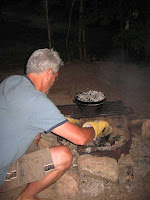A Brun
I A Serendipitous Mistake
In the aftermath of my vacation, I was refreshing my wild yeasts late one night, and I was a little sleep deprived. I had emptied my wild yeast container and reserved a single tablespoon of it, to which I intended to add 200g each of water and the Tartine Flour (a flour made up of 50:50 all purpose and whole wheat flours).
But it didn't feel right. It felt far too dense. I believe now that I had zeroed the tare on the scale, and then added flour to the water to get to 400g, effectively doubling the amount of flour that the starter would require. At any rate, I still had enough discard close by to start over. But instead of tossing this mistake away, I made some bread with it.
I kneaded it, then I covered it with a towel for the rest of the night -- about 6 hours I guess -- but in the morning it looked like nothing really had happened. There weren't many signs of fermentation, it seemed to have dried out on top. I scraped off some of these hard bits, scraped it up off the counter and kneaded it a bit with wet hands.
I let it sit for a bit (autolyse!) while I thought of what to do with it. After about 40 minutes I added some salt and water (not measuring it -- I guess I was still in vacation mode (aiming by sight and feel for less than the Tartine Bread amounts of ~20g salt and ~50g water, because I had less dough to work with). I also squalched in a small handful of rye kernels that were nice and moist -- I'd had them sitting in a thermos of boiling water overnight, and now they were sitting there cooling, awaiting soaking in a fruit juice I hadn't yet located.
I gave this whole thing a kneading for a couple of minutes and then folded it and put it in a bowl to cover. Then I fell asleep again, in hopes that I would get enough daytime sleep to get me through my first night back to work.
Three hours later, there was now sign of fermentation. But this was a tiny bit of dough, not enough for a real bread. I decided to bake it anyway.
I preheated the oven and tossed it in the Combo Cooker Dutch Oven, using the Tartine oven times and temperatures. This was a bit too hot for my little loaf, and the crust was a bit darker than I like, and it turned out to be a lot crunchier.
 |
| A brun is a small loaf, smaller than a bread, bigger than a bun |
I made sandwiches with it and took the entire loaflette with me to work. It turned out to be just the right size for that! It's like eating the two discarded ends of a batard that no one else wanted. Not a bread, not a bun, but something in between. A brunch bread. Or a brun (which my spell-checker wants to call a 'burn').
First Notes to Myself
II. Replicating the Amounts- Here I am just trying to write down what I think I did, in terms of ingredients and methods:
- 1 tbsp starter (a 50:50 flour of whole wheat and all purpose, hydrated 100%)
- 200g water
- 400g flour (a 50:50 mix of whole wheat and all purpose)
- Knead a couple of minutes until mixed. Let rise covered 6 hours. Knead with wet hands, incorporating the water. Autolyse 40-60 minutes.
- • Add ~3/4 tsp salt and
- ~ 40g water.
- Add small handful of cooked rye kernels or other prepared grain if you have them
- Knead until mixed together thoroughly. Fold once and put it in a bowl. Let rise for 4 hours. Preheat oven and Dutch Oven at the 3 1/2 hour mark to 500 degrees for 30 minutes. Tip the dough into the hot Dutch Oven with a spatula, resulting in a slightly elongated boule or foreshortened batard. Score it gently lengthwise. Bake covered at 450 degrees for 20 minutes, then remove lid for another 20 minutes. (This may have been a bit too long, but it makes a crisp, crunchy crust that shatters like a baguette's, if you like that sort of thing) Eat while warm if possible.
The next day I tried this basic idea again to see what I might get. But of course, I changed many of the ingredients,, while keeping more or less to the quantities. As my interest is in whole grains, here I used mostly whole wheat flour. I was still working nights, so I mixed this up when I got home from work and before falling asleep, thinking I'd bake it when I woke up. This means the fermenting times for this brun are different too :
⁃ 1 TBSP Rye Starter
⁃ 350g whole wheat flour
⁃ 50g rye flour
⁃ 200g water
I found this impossible to mix. The bran in the whole wheat flour must have soaked up all the water, making it so dry that I couldn't incorporate all the flour. I decided to add 50ml of water right away.
⁃ 50ml water
This turned out to be a bit much. though, and made the dough a bit slimier than I was looking for. After a short autolyse of 20 minutes, I added the salt with no further extra water and a small sieve-scoop of soaking rye berries.
⁃ ~ 3/4 tsp salt
⁃ ~ 1/4c soaked rye berries. These were soaked in homemade crabapple juice.
I kneaded this together and folded it: it is a tight, dense bit of dough, poorly hydrated. This I left in an oiled bowl for baking later that afternoon when I woke up.
It bulk fermented/proofed a mere 6 hours, at which point it looked kind of dried out on top, and of course, it had not risen much, it was still quite dense. It went directly into the hot pot in the oven without any further steps.
I baked it 20 minutes lid on, but only 15 minutes lid-off.
Results:
Again a crunchy crust, the whole wheat gives it quite a different texture and taste. This loaf had not been fermented as long as the first loaf, but it still made a bread. Probably if I had coated the whole loaflette in oil and retarded it in the refrigerator for another day before I baked it I would have had a better tasting loaf. But it was still perfectly acceptable.
I cut into this when it was still warm, and there were places in the middle that were a little furry, indicating to me that it could have used those extra 5 minutes of baking. Smells nutty and inviting. Tastes good -- but of course, not quite as good as a true Tartine Loaf, which is developed over the correct amounts of time, with the proper amount of folding.
This is bread that can be made in a pinch.
Second Notes to Myself
- The first loaf was maybe 60% hydrated (I used wet hands for a lot of shaping, so it was likely slightly more than this). The second loaf was 62.5% hydrated, but the soaked rye berries probably provided some extra moisture too.
- Check out the Tartine Bread book's recipes for baguettes, they are somewhat different than the loaves you have so far tried, and include, I think, less hydration and less fermentation, similar to what you have done here.
- These tinier, one-person-sized loaves remind me of a period of experimentation that I went through some time ago, when I was trying to see if I could, on my schedule, bake buns in the morning for breakfast. As I recall, that didn't work out too well; but I think that that whole experience took place when I had no real understanding of the growth cycle of the yeasts in dough, or how longer fermenting times can improve flavours. Even though the second loaf is still pretty dense and would have been better with a longer fermentation, I am simply amazed that I can make any kind of sourdough bread in the time allotted when I am sleeping days and working nights.
- That's a lot of bread to take to work. But remember: I am working nights, so sleeping through the family's daytime meals, and I am working 12 hours, so I am eating not much else besides what I take with me to work. Sometimes there are a few slices left over from those 12 hours, and I may eat them for breakfast on the way home. But the truth of the matter is, yes, that is a heck of a lot of bread for one person. The whole wheat brun is far more filling than the first brun. That speaks to the satiety of the whole grains. You don't require as much to feel full, and it takes longer to digest, leaving you satiated far longer. That means not as much sugar rush when the carbs hit. I still felt a bit tired after eating some of it though: but was that because it was the middle of the night? Postprandial narcolepsy is especially dangerous when you are driving home after working all night: in this case, carbs are not the best food of choice. Studies have shown a piece of fruit -- an apple or an orange for example -- are the better food to eat when driving tired.























































































